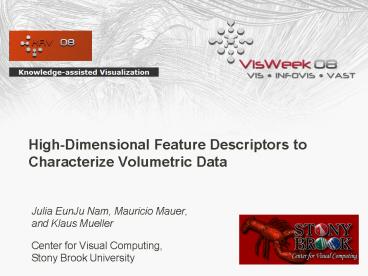HighDimensional Feature Descriptors to Characterize Volumetric Data - PowerPoint PPT Presentation
1 / 36
Title:
HighDimensional Feature Descriptors to Characterize Volumetric Data
Description:
High-Dimensional Feature Descriptors to Characterize Volumetric Data ... 2D flow simulation (time varying data) 3D time varying data ... – PowerPoint PPT presentation
Number of Views:115
Avg rating:3.0/5.0
Title: HighDimensional Feature Descriptors to Characterize Volumetric Data
1
High-Dimensional Feature Descriptors to
Characterize Volumetric Data
- Julia EunJu Nam, Mauricio Mauer,
- and Klaus Mueller
- Center for Visual Computing,
- Stony Brook University
2
Feature enhancement and detection
- Traditional Transfer function
RGB value, opacity
Density, Gradient
3
Semantic Perceptual Transfer Function - KAV 07
Second Order Moment
Density
Gradient
Curvature
LH Values
Third Order Moment
Skew
Kurtosis
Feature Vector
4
Cluster Analysis and Learning KAV 07
- Introduction of a large number of metrics creates
high-dimensional space. - It is impossible to handle with the transfer
function interface. - We proposed Cluster Analysis (CA) for this task.
- Create perceptual transfer function
- Cluster Analysis A strategy to explore high
dimensional data without a classification model
or a priori-hypothesis. - Find a collection of features to determine an
object(or feature) using CA. - Learn from classification models which are formed
by CA.
5
Cluster Analysis Example KAV 07
- Cluster Analysis to characterize iso-surfaces
(boundaries) - Semantic query for a specific object
- Display the boundary voxels of significant
objects with density D, each such object in a
different color.
6
Related Works
- Identify region boundaries using 2D
density-gradient plot G. Kindlmann, et.al. 98 - Multidimensional Transfer Function using
dual-domain J. Kniss et.al. 02 - Curvature-based transfer functions for direct
volume rendering, G. Kindlmann 03 - Painting-based High D Classification , F. Tzeng
et.al.05 - Visualization Boundaries using LH Histograms P.
Sereda et. al. 06
7
Semantic Perceptual Transfer Function
Shape
Second Order Moment
Density
Gradient
Curvature
LH Values
Third Order Moment
Skew
Kurtosis
8
Overview
- Goal 1 Acquire knowledge (KAV)
- Create feature models
- Model-based object level characterization
- Goal 2 Use knowledge for visualization (KAV)
- Object detection, classification, categorization
- Dataset summarization
- Enables feature inventory, indexing for
information visualization - How to describe texture?
9
Density Global Histogram
10
Density Local Histogram
- Density signatures in local histograms at
hierarchy of window sizes - Detect density statistics at multiple levels of
scales - Representation to capture the essence of an
object
11
SIFT (Scale Invariant Feature Transform )
- Gradient histogram of local neighborhood
- Highly expressive of a local neighborhoods
salient dynamics - Invariant to scale, translation and rotation
- Algorithm
- the detection of critical points (the keypoints)
in scale-space - the encoding of these into keypoint descriptors
12
SIFT (Scale Invariant Feature Transform )
- Find keypoints
- Local extremas in a difference-of-Gaussians in
multi-scale space - Discard low contrast keypoints
- Filter out those on edges
- Pictures from Wikepedia.org
13
SIFT (Scale Invariant Feature Transform )
- Keypoint descriptor
- Compute the magnitude and orientation at each
sample point around the keypoint location - Weighted by a Gaussian function to achieve a
certain level of smoothing. - Aggregated into orientation histograms describing
the neighborhood
14
3D SIFT
15
Analysis and Classification
- Goal Learn high level representation of the
sampled object using various feature vectors - Levels of interest
- Level-1 categories
- Level-2 category instances (within same
catergory) - Level-3 groups of similar individual features
- Test data
- 2D flow simulation (time varying data)
- 3D time varying data
16
Feature Extraction and N-D visualization
MDS ( Multi-Dimensional Scaling) - Flatten N-D
data into 2-D display while preserving the
inter-distance between dataset
17
MDS analysisCategorization
Water dropping from top-right to bottom-left
corner
Smoke flow starting from the bottom-center
Smoke flow narrower than smoke2
Smoke flow similar with smoke3
Smoke flow similar with smoke3 and 5
- Categorize different groups of flows
- Distinguish different features
- within same category
Smoke flow similar with smoke3,5, and 6 but
different direction
18
Cluster Analysis on Visual Contents
1
2
3
4
5
19
MDS Analysis on Visual Contents
Water 5-cl2 Water 4-cl0 Water 3-cl0 Water 2-cl2
Water 5-cl3 Water 5-cl0 Water 4-cl2 Water
3-cl4 Water 2-cl4
Water 5-cl1 Water 4-cl1 Water 3-cl3 Water 2-cl1
20
Grouping Similar Features In Different Flows
21
Categorization of CT volumes
22
Categorization of 3D flows
- 5 frames extracted from each series
- Features
- Global histogram
- Local histogram
- 3D SIFT
23
MDS analysis
24
Conclusion
- Built a general framework
- to support classification tasks
- needed in mining, browsing, searching, and
retrieval of sampled data - in large files or collection of files.
- Demonstrated how to construct feature models
- By visual cluster analysis
- Using rich set of feature vectors
- With 2D and 3D flow data
25
Future Work
- Automated system to find proper rendering
parameters - Associate the learned object and feature models
with information on appropriate rendering
parameters - Learn from user studies or automated observers
- Use other metrics for the feature vector
- Such as topological events for flow fields
26
Thank you
- Funding from DOE, NIH, NSF, PNL
- NVIDIA Professor Partnership equipment donation
27
More Results
28
Categorization of MRI volumes
29
MDS analysisCategorizing different flow patterns
Water dropping from top-right to bottom-left
corner
Same direction higher speed than water2
Same direction higher speed than water3
Same direction but small branch on the right
Different direction Different speed
30
2D SIFT vs. 3D SIFT
31
2D SIFT vs. 3D SIFT
32
Clustering on gradient magnitude to
identify candidates of boundary voxels.
33
Clustering on up history (the H-value).
34
Clustering on intensity to distinguish the D
intensity boundaries.
35
Clustering on spatial connectivity(position) to
separate regions.
36
2D Flow data 3D SIFT































